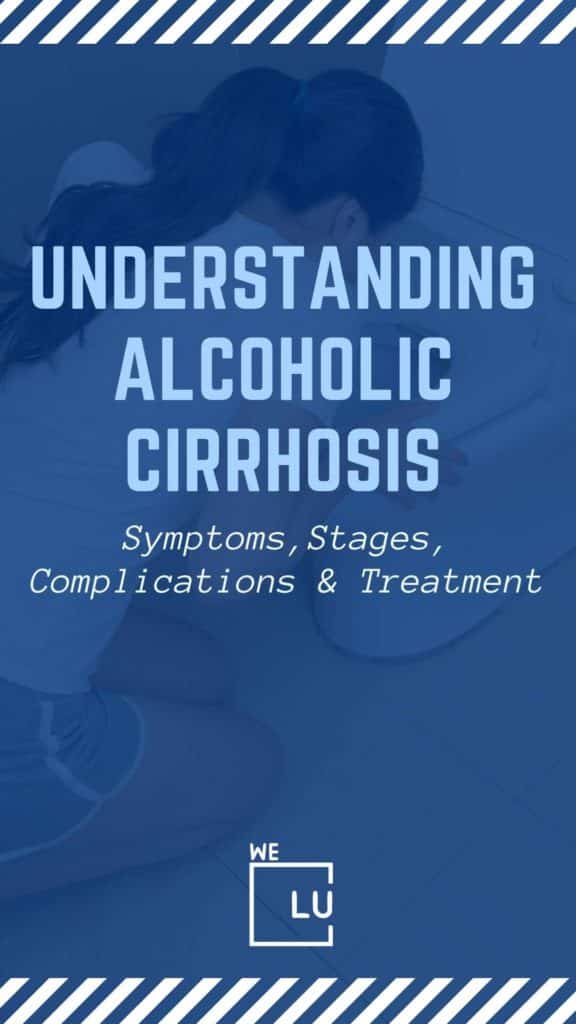The liver fulfills an extremely important function for the human body. It filters the blood of toxins, breaks down proteins, and creates bile to help the body absorb fats. Alcoholic Cirrhosis is a disease caused by excessive alcohol consumption. When a person drinks alcohol heavily over the course of decades, the body starts to replace the liver’s healthy tissue with scar tissue. As the disease progresses, and more of the healthy liver tissue is replaced with scar tissue, the liver will stop functioning properly. After heart disease and cancer, alcoholic cirrhosis is the third most common cause of death in people aged 45-65 years. [1]
According to the scientific piece, ‘Alcohol use disorder and the liver’ published by John Wiley & Sons Ltd., “alcohol use disorders (AUD) cause a range of physical harms, but the major cause of alcohol-related mortality is an alcohol-related liver disease (ALD), in some countries accounting for almost 90% of alcohol-related deaths. The risk of ALD has a positively correlated relationship with increasing alcohol consumption but is also associated with genetic factors, other lifestyle factors, and social deprivation. ALD includes a spectrum of progressive pathology, from liver stenosis to fibrosis and liver cirrhosis. There are no specific treatments for liver cirrhosis, but abstinence from alcohol is key to limit the progression of the disease”. [2]
Excessive drinking can cause scarring of the liver, a condition known as cirrhosis. Although most individuals who drink excessively do not develop cirrhosis, how much alcohol causes cirrhosis is usually unclear. Drinking too much over time can lead to alcoholic hepatitis and then to alcoholic cirrhosis.
According to the National Institute on Alcohol Abuse and Alcoholism (NIAAA), how much alcohol causes cirrhosis is dependent on how quickly a person drinks, how much they weigh, and how often they drink. Individuals who consume more than 6 servings of alcohol per day over several years are likely to develop cirrhosis; however, how much alcohol causes cirrhosis in any given individual can vary.
Symptoms of Alcoholic Cirrhosis
Unlike other serious diseases, alcohol-related liver disease (ARLD) does not cause any symptoms until the liver has been severely damaged. This fact makes alcoholic cirrhosis a silent condition at the beginning, therefore, more dangerous than other diseases that can be easily detected from an early stage. This means ARLD (or alcoholic cirrhosis) is frequently diagnosed during tests for other conditions, or as we previously said, at a stage of advanced liver damage. If you regularly drink alcohol to excess, tell your General Practitioner, so that they can check if your liver is damaged. [3]
Alcoholic Cirrhosis symptoms can include:
- Feeling Feverish
- Weight loss
- Loss of appetite
- Yellowing of the eyes and skin (Jaundice)
- Swelling in the ankles and abdomen
- Confusion or drowsiness
- Vomiting blood or passing blood in your stools

The Stages of Alcoholic Cirrhosis
According to NHS.UK, there are three main stages of Alcohol-Related Liver Disease (ARLD). Although there is no differentiated appearance of each one in most cases since there can be an overlap between each stage. These are the three stages:
- Alcoholic fatty liver disease: drinking a large amount of alcohol, even for just a few days, can lead to a build-up of fats in the liver. This is called alcoholic fatty liver disease, and is the first stage of ARLD. It rarely causes any symptoms, but it’s an important warning sign that you’re drinking at a harmful level. This condition is reversible, if you stop drinking alcohol for 2 weeks, your liver should return to normal.
- Alcoholic hepatitis: it is unrelated to infectious hepatitis, and is a potentially serious condition that can be caused by alcohol misuse over a longer period. When this develops, it may be the first time a person is aware they’re damaging their liver through alcohol. Less commonly, alcoholic hepatitis can occur if you drink a large amount of alcohol in a short period of time (binge-drinking). The liver damage associated with mild alcoholic hepatitis is usually reversible if you stop drinking permanently. Severe alcoholic hepatitis, however, is a serious and life-threatening illness. Many people die from the condition each year in the UK, and some people only find out they have liver damage when their condition reaches this stage.
- Cirrhosis: is a stage of ARLD where the liver has become significantly scarred. Even at this stage, there may not be any obvious symptoms. It’s generally not reversible, but stopping drinking alcohol immediately can prevent further damage and significantly increase your life expectancy. A person who has alcoholic cirrhosis and does not stop drinking has a less than 50% chance of living for at least 5 more years. [3]
COVID-19 Impact
As has happened with other diseases, the COVID-19 virus has deeply affected people suffering from Alcoholic Cirrhosis. There is a higher risk of mortality for people suffering from this during the pandemic than it was before it. As maintained by the scientific article ‘Mortality Trends in Chronic Liver Disease and Cirrhosis in the United States, Before and During COVID-19 Pandemic’, published on Science Direct, Chronic liver disease (CLD) and cirrhosis accounts for approximately 2 million deaths annually worldwide.
CLD and cirrhosis-related mortality has increased steadily in the United States. With the global pandemic of coronavirus disease (COVID-19), patients with CLD and cirrhosis represent a vulnerable population at higher risk for complications and mortality. [4]

Possible Alcoholic Cirrhosis Complications
Death rates linked to ARLD have risen considerably over the last few decades. Alcohol misuse is now one of the most common causes of death in the US, along with smoking and high blood pressure. According to Nhs.Uk, life-threatening complications of ARLD include:
- Portal hypertension and varices: Portal hypertension is a common complication of alcoholic cirrhosis and, less commonly, alcoholic hepatitis. It occurs when the blood pressure inside your liver has risen to a potentially serious level. When the liver becomes severely scarred, it’s harder for blood to move through it. This leads to an increase in the pressure of blood around the intestines. The blood must also find a new way to return to your heart. It does this by using smaller blood vessels. But these vessels are not designed to carry the weight of blood, so they can become stretched out and weakened. These weakened blood vessels are known as varices. If the blood pressure rises to a certain level, it can become too high for the varices to cope with, causing the walls of the varices to split and bleed. This can cause long-term bleeding, which can lead to anemia. Alternatively, the bleeding can be rapid and massive, causing you to vomit blood and pass stools that are very dark or tar-like. Split varices can be treated by using an endoscope to locate the varices. A tiny band can then be used to seal the base of the varices.
- Ascites: A person with portal hypertension may also develop a build-up of fluid in their abdomen (tummy) and around the intestines. This fluid is known as ascites. Initially, this can be treated with water tablets (diuretics). If the problem progresses, many liters of fluid can build up, which needs to be drained. This is a procedure known as paracentesis and involves a long, thin tube being placed into the fluid through the skin under local anesthetic. One of the problems associated with the development of ascites is the risk of infection in the fluid (spontaneous bacterial peritonitis). This is a potentially very serious complication and is linked to an increased risk of kidney failure and death.
- Hepatic encephalopathy: One of the most important functions of the liver is to remove toxins from your blood. If the liver is unable to do this due to alcoholic cirrhosis, the levels of toxins in the blood increase. A high level of toxins in the blood due to liver damage is known as hepatic encephalopathy. Symptoms of hepatic encephalopathy include:

Hepatic encephalopathy: One of the most important functions of the liver is to remove toxins from your blood. If the liver is unable to do this due to alcoholic cirrhosis, the levels of toxins in the blood increase. A high level of toxins in the blood due to liver damage is known as hepatic encephalopathy. Symptoms of hepatic encephalopathy include:
- Agitation
- Confusion
- Disorientation
- Muscle stiffness
- Muscle tremors
- Difficulty speaking
- In very serious cases, a coma
- Hepatic encephalopathy may require hospital admission. In hospital, body functions are supported and medicine is used to remove toxins from the blood. [5]
Alcoholic Cirrhosis Treatment in California
At the moment, there is no specific treatment for ARLD, the best way to slow the damage of the disease is to stop drinking. Preferably for the rest of one’s life. This reduces the risk of further damage to your liver and gives it the best chance of recovering. Although, when this happens to someone that depends on alcohol, stopping drinking can be very difficult. But there’s always support, advice, and medical treatment that can be found. We Level Up Treatment Center can provide everything you may need to go through a difficult condition like this. [6]
As stated by Nhs.Uk, “A liver transplant may be required in severe cases where the liver has stopped functioning and does not improve when you stop drinking alcohol. You’ll only be considered for a liver transplant if you have developed complications of cirrhosis despite having stopped drinking. All liver transplant units require a person to not drink alcohol while awaiting the transplant, and for the rest of their life”.
Alcohol Treatment Center in California
If you’re suffering from Alcohol Cirrhosis and feel like you just can’t stop drinking, we can offer the support you need. We Level Up Treatment Center can provide you, or someone you know, the tools to treat alcoholism professionally and safely. Feel free to call us to speak with one of our counselors, we can inform you about this condition by giving you relevant information, our specialists know what you are going through. Have in mind that each call is private and confidential.
Sources:
[1] Alcoholic Liver Cirrhosis – Healthline.com
[2] Alcohol use disorder and the liver – Ryan Buchanan, Julia M. A. Sinclair. Addiction published by John Wiley & Sons Ltd. On behalf of the Society for the Study of Addiction
[3] Overview. Alcohol-related liver disease – Nhs.Uk
[4] Mortality Trends in Chronic Liver Disease and Cirrhosis in the United States, Before and During COVID-19 Pandemic – Science Direct
[5] Complications. Alcohol-related liver disease – Nhs.Uk
[6] National Institute of Diabetes and Digestive and Kidney Diseases – https://www.niddk.nih.gov/health-information/liver-disease/cirrhosis
